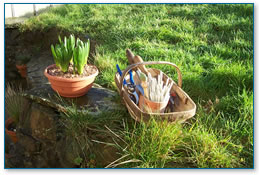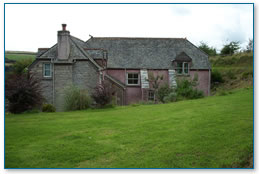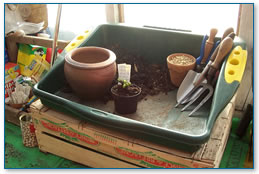homes,
rivers and land management
 |
House and garden |
In the case of land management
for schools, industries or farms, reasonably large areas of land
have been talked about. However, every little helps and good land
management at home can have a very positive effect on the environment.
If you start on a small scale with good ideas and enthusiasm it
sets an example and is a starting point for meeting bigger challenges!
Start by thinking about the land
surrounding your home, this might include a front and/or back garden
and a driveway. Of course the type of garden you have, whether it
is a small back yard, a window box or a field, will depend upon
where you live in Cornwall.
 |
Flower Pot Garden |
The type of plants that grow in your garden will also depend on
where you live in the region, for example if you live on the moor
the soil in your garden is likely to be acidic – see Fact
Section (L11).
 |
Farm garden |
If you live on a cliff or sea
front your garden might be exposed to sea breezes which carry salt.
Different plants will grow better in different conditions. Rather
than trying to grow plants that are not suited to the soil and climate,
find out what plants would do better in your garden (see the Garden
Advice website). It is then a lot easier to manage the
land, and you will not have to battle to make things grow or have
to use chemicals.
 |
Garden tools & plant food |
Some plants need lots of water and grow naturally in wet tropical
countries or places with high rainfall. These plants might be okay
in the Autumn, Winter and Spring, but in the Summer when Cornwall
often does not have any rain for several weeks, perhaps even a month,
they will still need water. It is at this time of year that water
demands are greatest for household use and it is also at this time
that rivers, streams and ponds become low and even dry up!
 |
| Garden with shrubs |
Planning a garden that does not
need a lot of watering helps to reduce the demand. Designing a garden
that requires little or no watering can be fun and challenging,
have a go at finding out what kinds of plants need little water.
There are many ways to help save water, go to the Water Efficiency
section of this CD to find out more (E04).
Gardens can also be used as ‘buffer
zones’ (G1), so
that the plants growing in them help to breakdown any harmful waste
before it can enter a watercourse. In cities, towns and villages
there is plenty of tarmac and concrete to be found. It is used for
roads, car parks, driveways, patios and pavements. Tarmac and concrete
are not porous materials, this means that water will not soak through
but runs off the surface - a bit like spilling water onto a plastic
table.
|
|
Rainwater flowing
into a roadside drain |
Carpark run off area |
Usually rainwater is directed
into a drain and carried away to be treated and used to supply water
to homes, industries and farms. The water cycle has been intercepted!
(see Water Cycle page B02)
but some dirty water finds its way into streams and rivers. If this
water could be cleaned by nature in a buffer zone before entering
a river, then the way the land or garden is used and managed could
help rivers and wildlife.
The diagram below shows how a
wetland pond area is used to treat rainwater that has fallen onto
a car park and become contaminated with oil left on the surface
by the cars and vehicles using it.
Water Treatment Area Design
from Pennywell Ed pack
click on the picture to open an enlarged printer friendly version
For more information about
ponds see Ponds & Lakes section and the Pond Design section
(F05 &
F06)
|

